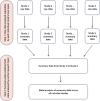The Mortality After Release from Incarceration Consortium (MARIC): Protocol for a multi-national, individual participant data meta-analysis
- PMID: 32935053
- PMCID: PMC7473255
- DOI: 10.23889/ijpds.v5i1.1145
The Mortality After Release from Incarceration Consortium (MARIC): Protocol for a multi-national, individual participant data meta-analysis
Abstract
Introduction: More than 30 million adults are released from incarceration globally each year. Many experience complex physical and mental health problems, and are at markedly increased risk of preventable mortality. Despite this, evidence regarding the global epidemiology of mortality following release from incarceration is insufficient to inform the development of targeted, evidence-based responses. Many previous studies have suffered from inadequate power and poor precision, and even large studies have limited capacity to disaggregate data by specific causes of death, sub-populations or time since release to answer questions of clinical and public health relevance.
Objectives: To comprehensively document the incidence, timing, causes and risk factors for mortality in adults released from prison.
Methods: We created the Mortality After Release from Incarceration Consortium (MARIC), a multi-disciplinary collaboration representing 29 cohorts of adults who have experienced incarceration from 11 countries. Findings across cohorts will be analysed using a two-step, individual participant data meta-analysis methodology.
Results: The combined sample includes 1,337,993 individuals (89% male), with 75,795 deaths recorded over 9,191,393 person-years of follow-up.
Conclusions: The consortium represents an important advancement in the field, bringing international attention to this problem. It will provide internationally relevant evidence to guide policymakers and clinicians in reducing preventable deaths in this marginalized population.
Key words: Mortality; incarceration; prison; release; individual participant data meta-analysis; consortium; cohort.
Conflict of interest statement
Statement of Conflicts of Interest: SF is on the UK’s Independent Advisory Board on Deaths in Custody. PC has received grants from Abbvie and Echosens to conduct research relating to prison health. IB has received royalties from Uptodate for educational content on health care for incarcerated persons. All other authors report no conflicts of interest.
Figures
References
-
- UNODC, ILO, UNDP, WHO, UNAIDS. HIV prevention, treatment and care in prisons and other closed settings: A comprehensive package of interventions. Vienna: United Nations Office of Drugs and Crime; 2013 https://www.unodc.org/documents/hiv-aids/HIV_comprehensive_package_priso...
-
- Walmsley R. World Prison Population List (twelfth edition): Home Office, London UK; 2018 https://www.prisonstudies.org/sites/default/files/resources/downloads/wp...
-
- Minton T, Ginder S. Census of Jails: Population Changes, 1999–2013. US Department of Justice, Bureau of Justice Statistics; NCJ 248627 2015. https://www.bjs.gov/content/pub/pdf/cjpc9913.pdf
-
- Minton T. Jail Inmates at Midyear 2012 - Statistical Tables. Washington, DC: US Bureau of Justice Statistics; 2013 https://www.bjs.gov/content/pub/pdf/jim12st.pdf
Grants and funding
LinkOut - more resources
Full Text Sources


